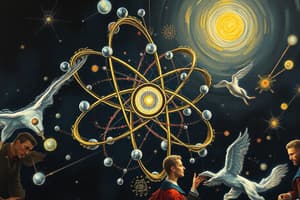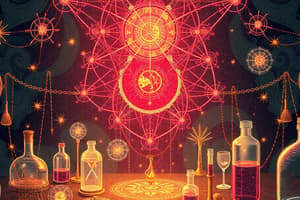Podcast
Questions and Answers
What is the charge of a proton?
What is the charge of a proton?
- No charge
- Negatively charged
- Positively charged (correct)
- Electrically neutral
In what way do neutrons differ from protons?
In what way do neutrons differ from protons?
- Neutrons have a negative charge
- Neutrons are electrically neutral (correct)
- Neutrons have a positive charge
- Neutrons have no mass
What happens to an atom when it loses electrons?
What happens to an atom when it loses electrons?
- Becomes more negatively charged
- Becomes electrically neutral
- Remains neutral
- Becomes more positively charged (correct)
Which technique allows for the measurement of the radiative lifetimes of excited atomic states with great accuracy?
Which technique allows for the measurement of the radiative lifetimes of excited atomic states with great accuracy?
What is the role of electrons in determining the nature of an atom?
What is the role of electrons in determining the nature of an atom?
What role does computational modeling play in understanding atomic structures?
What role does computational modeling play in understanding atomic structures?
How do physicists use calculations based on computational modeling?
How do physicists use calculations based on computational modeling?
Why is precise atomic structure knowledge crucial for practical applications?
Why is precise atomic structure knowledge crucial for practical applications?
What ensures that scientific advances remain grounded in reality?
What ensures that scientific advances remain grounded in reality?
In what areas do scientific advances based on computed atomic structures foster growth?
In what areas do scientific advances based on computed atomic structures foster growth?
Flashcards are hidden until you start studying
Study Notes
Atomic Structures and Subatomic Particles
Understanding the makeup of atoms and their constituent parts is a vital component of modern science. The field of atomic structure encompasses a diverse array of disciplines—from chemistry and physics to astronomy and technology. Here we delve into the world of subatomic particles, which are the building blocks of atoms themselves.
Neutral and Highly Ionic Species
Atoms have three basic components: protons, neutrons, and electrons, each with its own specific role in determining the nature of the atom itself. Protons are positively charged, neutrons are electrically neutral, and electrons carry a negative charge. These elementary particles combine to create the neutral atom. However, when atoms lose or gain electrons due to various reasons, they become either negatively or positively charged, forming what are known as ions.
Experimental Techniques and Methodologies
Advances in technology have allowed scientists to investigate the behavior of electrons within atoms with unprecedented precision. Laser spectroscopy is one technique that measures the radiative lifetimes of excited atomic states with great accuracy, providing insights into how electrons move around inside atoms. Furthermore, the development of ion traps has enabled researchers to perform precise experiments on highly charged ions, shedding light on subtle effects such as hyperfine structure and isotope shifts.
Theoretical Frameworks
Computational modeling plays a crucial role in understanding atomic structures. Modern theories and algorithms simulate the interactions of electrons with each other and the rest of the atom, allowing physicists to make predictions about the properties of atoms and their components. These calculations help identify discrepancies in existing data or reveal gaps where further exploration is needed.
Practical Usage and Future Directions
Precise atomic structure knowledge is critical for numerous practical applications across various sectors, including laboratory spectroscopy, quantum computation, plasma research, nuclear fusion, lighting design, and astrophysics. Continuous improvement in measurements and theoretical frameworks ensures that scientific advances remain grounded in reality, fostering growth in areas that range from everyday life to cosmic mysteries.
Studying That Suits You
Use AI to generate personalized quizzes and flashcards to suit your learning preferences.




